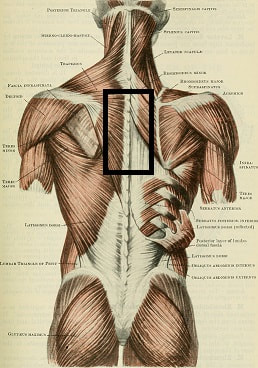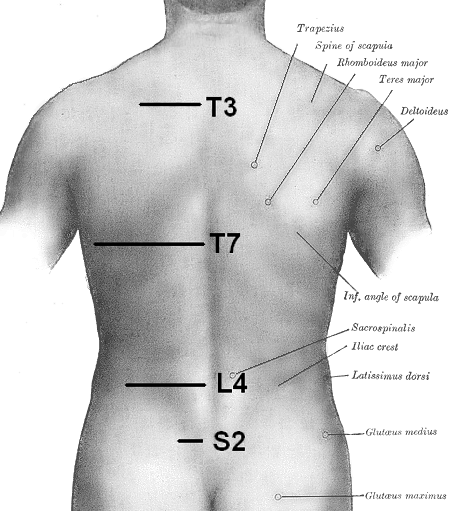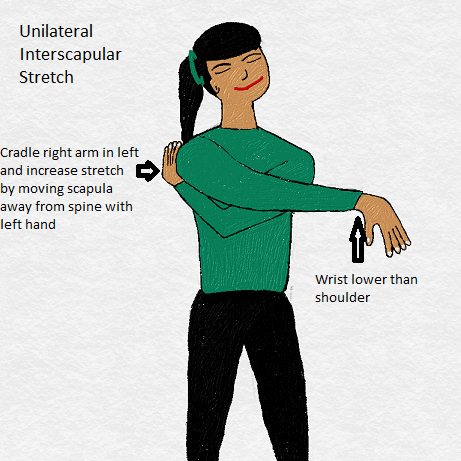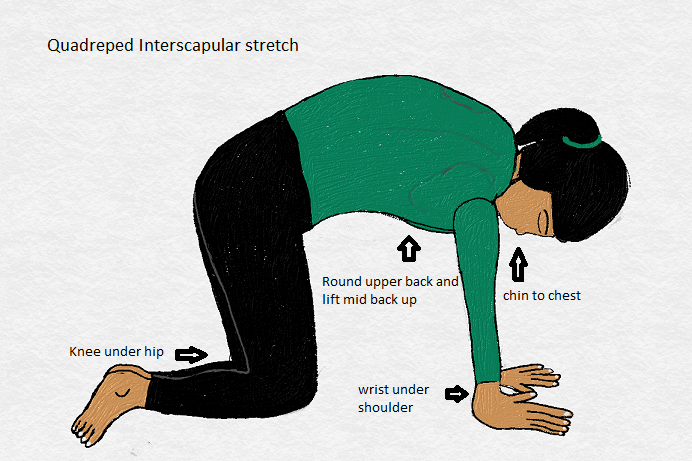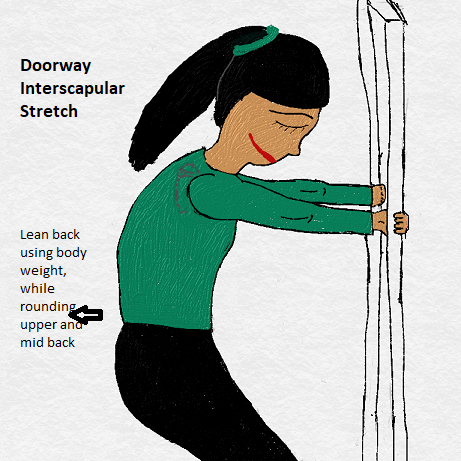|
This week we will look at inter-scapular stretch.
The word inter-scapular literally means the area between the two scapulae or the shoulder blades. The scapula is a bone that sits on the posterior wall of the rib cage and is held in place by its soft tissue attachments. The scapula-thoracic joint is not a regular synovial joint, hence there is no bone to bone approximation with either the vertebrae or ribs which is enclosed by a joint capsule, and is unique from that perspective. It varies in its placement over the ribs. Normally it lies between the T1-T7 vertebrae with the base of scapular spine at T3 level and the inferior angle at T7 spinous process. It also varies in its placement medio- laterally and usually the distance between the medial borders of the scapulae to the vertebral spinous process at T3 level is 6-10 cm. The left and right scapula in the same individual may be situated differently over the rib cage, given the fact that it does not form a synovial joint and is only held in place by muscular attachments. As a physical therapist, what is important during examination is whether the left and right scapula are situated similarly within the same individual. Studies in multiple subjects only helps determine a range of “normal “or “acceptable” placement and would alert of gross dyskinesis leading to symptomatic conditions. History in these cases is important as is the overall postural alignment. Fine tuning the scapulae and balancing them bilaterally by releasing the tight muscles and developing smooth and coordinated motor control at scapula-thoracic, shoulder, and acromio-clavicular joints leads to stable movement. That being said, we will look at inter-scapular stretch in healthy individuals who are asymptomatic to maintain normal scapular alignment. There are several muscle attachments to the medial border of the scapula, namely, the levator scapulae, rhomboid minor and major, and the serratus anterior. The trapezius muscles originate from the spinal vertebrae, the occiput, and ligamentum nuchae and the various fibers insert into the clavicle, the spine of scapula, and acromion process. In addition, the superficial postural muscles or erector spinae (iliocostalis, spinalis, longissimus) and deep postural muscles (semispinalis, multifidi) also traverse this area. Clinically, a skilled therapist may be able to locate the trigger points or tight muscle/ tendons through palpation. Since the presentation and symptoms may vary widely, what is of significance though is a healthy range of motion in the scapula and shoulder joint which is balanced and bilaterally symmetrical. For these stretches our presumption is tightness in the muscles between the shoulder blades with a shorter distance from the spine to medial border of scapula. In this case, the shoulders are drawn back and scapula may appear squeezed or closer together. Generally speaking, when the shoulders are rounded, the pectorals are tight and should be addressed with chest and shoulder opening stretches. When asymmetrical, do the stretches on the tighter side. When one side is tighter than the other, first priority will be to balance both sides by stretching and working on the tighter tissue, then follow up with bilateral stretches when balanced. Passive Stretching Techniques Passive techniques will encompass manual release by therapist which is very effective for these muscles. Myofascial release techniques to relieve trigger points and increase flexibility in soft tissue. Passive stretches may be done manually also, since this is a small and freely moving bone which may be manually protracted to get a stretch in the inter-scapular muscles. Active Stretch: i) Unilateral stretch in the inter-scapular area may be achieved by lifting the arm up at the shoulder and drawing it across the chest to the other side. The wrist should be slightly lower than the shoulder joint. It is important to keep the shoulder blade neutral (not elevated) when beginning this stretch. This stretch may stretch the posterior shoulder capsule as well. Emphasis should be placed to feel the stretch between shoulder blades by continuing to stretch a little further so the scapula is pulled across the back to the side being stretched. . Hold stretch for 5-30 seconds. Release and repeat 2-3 times. ii) Another way to stretch the inter-scapular area is in quadruped position with wrists directly below the shoulders and knees below the hips. A good starting position makes the stretch easier by targeting accurate soft tissue. Slowly bring chin to chest while lifting and rounding the upper and mid-back. The scapulae move outwards along the ribs, stretching the inter-scapular area. Hold stretch for 5-30 seconds. Release and repeat 2-3 times. iii) An additional stretch involves facing a sturdy open doorway while standing with feet hip width apart a few inches from the doorway. With the shoulders internally rotated and forearms pronated hold onto door way on both sides with a hook grip so that the thumb is pointing to the floor. Lean back using body weight as you round the shoulders and upper and mid-back area as if you are hanging on the hands. Hold stretch for 5-30 seconds. Release and repeat 2-3 times. Stretch with equipment or tools: i) Foam Roller and Tennis Ball Stretch: The best tool to stretch the interscapular area initially is a foam roller. Place the foam roller on the floor and lie on it facing upwards so that the roller targets the area between the shoulder blades. Make sure the transverse abdominus is engaged for a neutral lumbar spine. Roll the foam roller sideways to stretch. As you progress, you may try a tennis ball between the shoulder blades on the floor or in standing position with the ball in the inter-scapular area between the wall and your shoulder blades. Apply pressure gradually to tolerance and roll the ball by small circular motion or just hold in place for 5-30 seconds, when ball is directly over tight spot. (P.S. The 2 anatomical pictures are modified from Wikimedia Commons.)
0 Comments
Your comment will be posted after it is approved.
Leave a Reply. |
Details
AuthorAmi Gandhi is a licensed physical therapist in the state of California. She is the owner of StableMovement Physical Therapy, a small boutique practice in San Jose that offers patient centered, one-on-one, hands-on physical therapy. Archives
March 2018
Categories |
